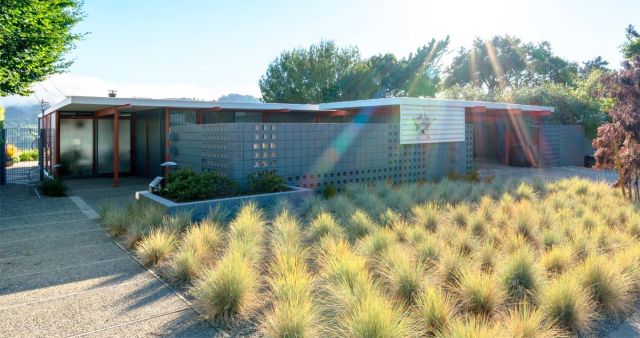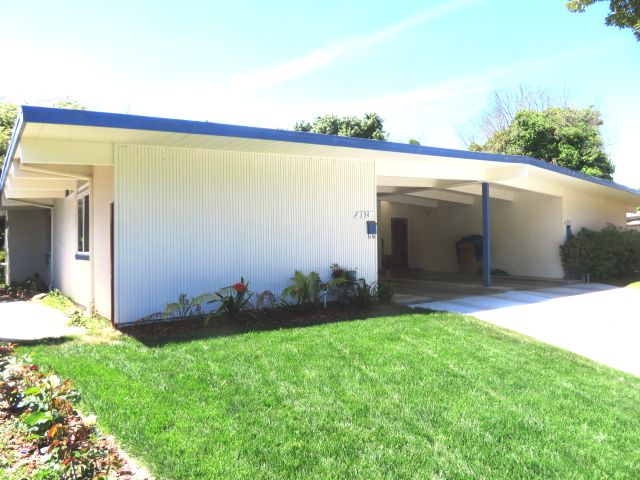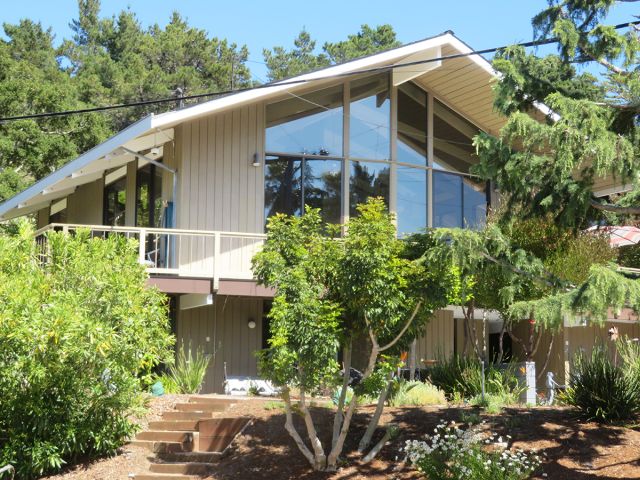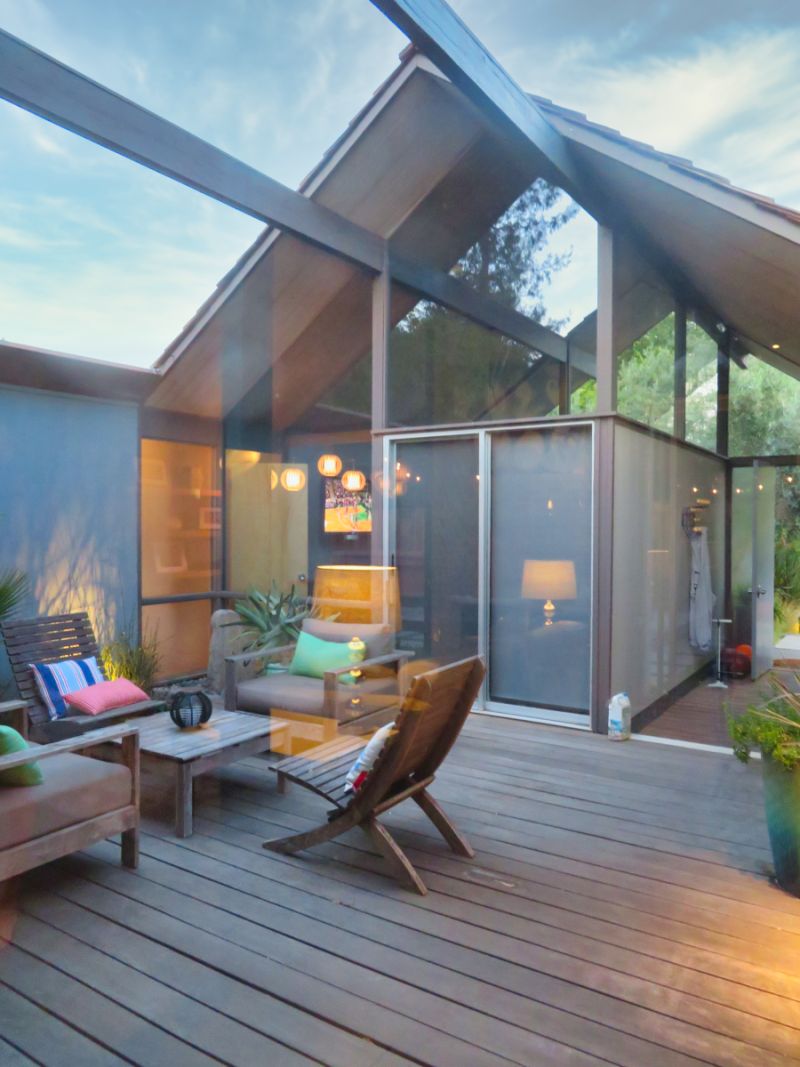
Joe Eichler Timeline 3: Experiments Mark the 1950s
 |
There are developers who find a formula and stick with it: a type of house, a standard floor plan that they flip and fuss with but never leave, a way of doing business just like every other developer does business.
By the mid-1950s people knew Joe was not that sort of developer. Sell to African-Americans when few others would? Sure.
Work with architects when tract builders were urged not to. Of course.
Build an experimental house or two? Why not? It might make news!
This is our third installment of the Eichler Timeline. Read parts one and two.
 1955. When neighbors in Terra Linda protest after Eichler Homes sells a home to a Black family, Eichler insists that he will sell to people of any race. His son Ned visits the complainers – and offers to buy back their homes if they feel that strongly about it. The controversy makes it onto the nightly news. 1956. Eichler serves as San Mateo county chairman for Adlai Stevenson, the liberal Democrat running for president in 1956. 1956. Eichler builds his first and probably only duplex homes. Eichler Homes builds five duplex homes – a total of ten units, with low-gabled roofs, on a cul-de-sac on Roble Avenue in Redwood City – another example of the firm’s diversity of housing types. They are built as rentals. Jones & Emmons had designed earlier duplexes for Eichler in 1953 that were never built.
1956. Eichler builds his only shopping center, Edgewood Plaza in Palo Alto. It is adjacent to his subdivision Green Gables. Designers are Jones & Emmons. In 1957 the Eichler Homes office building is added on the site by the same architects, and is occupied by Eichler Homes until the company folds in 1966. 1956. The all-steel X-100 home is built in San Mateo Highlands, to a design by A. Quincy Jones, to show off innovative design features and as a marketing tool for the subdivision. Jones’ own home in Los Angeles was steel. 150,000 people visit the X-100 during its three-month opening. It is one of two steel homes Eichler builds. The other, the All-Steel Builders Home, had been designed by architect Raphael Soriano and built in Palo Alto in 1955. 1957. ‘Eichler Medical Building’ is planned for Los Altos. The Jones & Emmons design, which would include a radiology lab, is never carried out. 1957-1958. The atrium, an outdoor room surrounded by indoor living areas and, generally, by the home’s front façade, is developed and first produced in 1958. It becomes a signature feature of many Eichler homes to come. Anshen suggests the feature. A few earlier models had courtyards that anticipated the atrium.
1957. Jones & Emmons publish 'Builders Homes for Better Living,' a book that explores the value not just of modern homes but of modern planning principles. Many of the homes and communities cited are by Eichler. 1958. Eichler builds the 'Life House,' a one-off, split-level design by esteemed architect Pietro Belluschi. Built in San Mateo Highlands, in partnership with Life magazine, it is also featured in the magazine. A year later, at the request of a Stanford professor, Eichler builds him a copy of the home on campus. 1958. Eichler resigns from the National Association of Home Builders to protest the group’s opposition to a court ruling that would require builders to sell to African-Americans and other minorities. Eichler does so publicly and his stance gets extensive industry press. 1959. The Streng Brothers begin building Eichler-inspired homes in the Sacramento Valley. Bill and Jim Streng visit Eichler homes, speak with Joe, and receive his encouragement. Working with Carter Sparks, a talented architect who had worked for Anshen and Allen, they develop an interior 'atrium' concept that fits the hotter climate. That same year Robert Rummer begins building what are essentially Eichler knockoffs in Portland.
1960. Eichler makes his first bid to develop an urban neighborhood, with Anshen and Allen submitting a plan to San Francisco’s Redevelopment Agency to build the Golden Gateway – near the site of the produce market where Nye & Nissen, a company from Eichler's past, used to sell its butter and eggs. Eichler is not chosen. 1960. Eichler drops Anshen and Allen and contracts instead with a new firm, Claude Oakland & Associates. Eichler had suggested to Oakland, who worked for Anshen and Allen during the 1950s, that if he formed his own firm, he would get the Eichler account. Eichler continues to work with Jones & Emmons as well. Architect Kinji Imada, who had studied at Harvard with Walter Gropius and had met Oakland at Anshen and Allen, joins Oakland and remains till his partner’s death in 1989. 1960. Jonas Harschel joins Eichler Homes. Like many employees of Eichler Homes, Harschel strongly supports the firm’s policy of not discriminating again African-Americans or other minorities. He works in several subdivisions as a 'troubleshooter,' stepping in when homes were slow to sell. “Then I would use my imagination and sell them,” he recalled. Learn more about Joe Eichler in our article Joe Eichler Timeline 4: Triumphs, Tragedy in the ‘60s. |
- ‹ previous
- 358 of 677
- next ›






